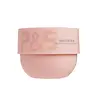What's inside
What's inside
 Key Ingredients
Key Ingredients

 Benefits
Benefits

 Concerns
Concerns

 Ingredients Side-by-side
Ingredients Side-by-side

Water
Skin ConditioningHydrolyzed Milk
EmollientStearic Acid
CleansingGlutathione
Kojic Acid
AntioxidantTocopherol
AntioxidantPrunus Amygdalus Dulcis Oil
Skin ConditioningHydrated Silica
AbrasiveClay
AbsorbentGlycol Distearate
EmollientPhenoxyethanol
PreservativeSodium Polyacrylate
AbsorbentNiacinamide
SmoothingCentella Asiatica Extract
CleansingTitanium Dioxide
Cosmetic ColorantPolyquaternium-7
Caprylyl Glycol
EmollientDisodium EDTA
Pearl Extract
AntioxidantLactic Acid
BufferingSodium Benzoate
MaskingParfum
MaskingWater, Hydrolyzed Milk, Stearic Acid, Glutathione, Kojic Acid, Tocopherol, Prunus Amygdalus Dulcis Oil, Hydrated Silica, Clay, Glycol Distearate, Phenoxyethanol, Sodium Polyacrylate, Niacinamide, Centella Asiatica Extract, Titanium Dioxide, Polyquaternium-7, Caprylyl Glycol, Disodium EDTA, Pearl Extract, Lactic Acid, Sodium Benzoate, Parfum
Water
Skin ConditioningPropylene Glycol
HumectantGlycerin
HumectantSorbitol
HumectantSodium Stearate
CleansingSodium Cocoyl Isethionate
CleansingSodium Myristate
CleansingSodium Palmitate
CleansingSodium Laurate
CleansingTitanium Dioxide
Cosmetic ColorantParfum
MaskingCoffea Arabica Seed Powder
AbrasiveCamellia Sinensis Leaf Extract
AntimicrobialCocos Nucifera Oil
MaskingGlutathione
Ascorbic Acid
AntioxidantCurcuma Longa Root Powder
Skin ConditioningHoney Extract
HumectantTamarindus Indica Fruit Extract
Skin ConditioningWater, Propylene Glycol, Glycerin, Sorbitol, Sodium Stearate, Sodium Cocoyl Isethionate, Sodium Myristate, Sodium Palmitate, Sodium Laurate, Titanium Dioxide, Parfum, Coffea Arabica Seed Powder, Camellia Sinensis Leaf Extract, Cocos Nucifera Oil, Glutathione, Ascorbic Acid, Curcuma Longa Root Powder, Honey Extract, Tamarindus Indica Fruit Extract
 Reviews
Reviews

Alternatives
Ingredients Explained
These ingredients are found in both products.
Ingredients higher up in an ingredient list are typically present in a larger amount.
Glutathione is an antioxidant naturally found in our bodies. It is made up of three amino acids: glycine, cysteine, and glutamic acid.
As an antioxidant, it prevents oxidative damage to parts of our cell.
While glutathione is said to help with fading dark spots, the results from research are inconclusive. Further studies are needed. With that said, gluthatione has been shown to protect our skin from UV-B induced damage.
This ingredient is naturally occurring in plants, animals, fungi, and some bacteria.
Learn more about GlutathioneParfum is a catch-all term for an ingredient or more that is used to give a scent to products.
Also called "fragrance", this ingredient can be a blend of hundreds of chemicals or plant oils. This means every product with "fragrance" or "parfum" in the ingredients list is a different mixture.
For instance, Habanolide is a proprietary trade name for a specific aroma chemical. When used as a fragrance ingredient in cosmetics, most aroma chemicals fall under the broad labeling category of “FRAGRANCE” or “PARFUM” according to EU and US regulations.
The term 'parfum' or 'fragrance' is not regulated in many countries. In many cases, it is up to the brand to define this term.
For instance, many brands choose to label themselves as "fragrance-free" because they are not using synthetic fragrances. However, their products may still contain ingredients such as essential oils that are considered a fragrance by INCI standards.
One example is Calendula flower extract. Calendula is an essential oil that still imparts a scent or 'fragrance'.
Depending on the blend, the ingredients in the mixture can cause allergies and sensitivities on the skin. Some ingredients that are known EU allergens include linalool and citronellol.
Parfum can also be used to mask or cover an unpleasant scent.
The bottom line is: not all fragrances/parfum/ingredients are created equally. If you are worried about fragrances, we recommend taking a closer look at an ingredient. And of course, we always recommend speaking with a professional.
Learn more about ParfumTitanium dioxide is a mineral UV filter widely used in sunscreens and cosmetics.
It is one of only two UV filters officially classified as “mineral” by regulatory agencies, the other being zinc oxide.
Titanium dioxide provides broad-spectrum protection mostly in the UVB and UVAII range, with some protection in the UVAI range.
While its UVA protection isn’t as strong as zinc oxide’s, the difference is minor.
A common myth is that mineral UV filters reflect UV light. However, modern research shows titanium dioxide absorbs UV radiation like chemical filters (~95% absorption & 5% reflection).
Thanks to its non-irritating nature, titanium dioxide is suitable for sensitive, acne-prone, or redness-prone skin. It is unlikely to cause "eye sting" like other sunscreen ingredients.
A major drawback of this ingredient is its white cast and thick texture. This is why mineral sunscreens often leave a white cast and are less cosmetically elegant than chemical/hybrid sunscreens.
To improve white cast and spreadability, micronized or nano-sized titanium dioxide is often used.
There are ongoing concerns surrounding nano-titanium oxide's impact on marine ecosystems.
There is no conclusive evidence that any form of titanium oxide (or any other sunscreen ingredients) will cause harm to marine ecosystems or coral reefs. The science is still developing but many consumers are keeping a close eye on this issue.
Please note, many destinations have reef-safety sunscreen rules. For instance, the U.S. Virgin Islands advises all visitors to use non-nano mineral sunscreens.
Nano mineral sunscreens once raised safety concerns about absorption into skin.
Extensive research has shown that they do not penetrate healthy or damaged skin; they remain safely on the surface and the top layer of dead skin (stratum corneum).
You'll likely find titanium dioxide bundled with alumina, silica, or dimethicone. These ingredients help make titanium dioxide highly photostable; this prevents it from interacting with other formula components under UV light.
Learn more about Titanium DioxideWater. It's the most common cosmetic ingredient of all. You'll usually see it at the top of ingredient lists, meaning that it makes up the largest part of the product.
So why is it so popular? Water most often acts as a solvent - this means that it helps dissolve other ingredients into the formulation.
You'll also recognize water as that liquid we all need to stay alive. If you see this, drink a glass of water. Stay hydrated!
Learn more about Water